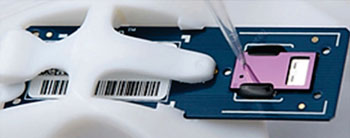Lab-on-Chip Identifies and Differentiates Tropical Pathogens
By LabMedica International staff writers
Posted on 13 Aug 2014
Tropical pathogens often cause febrile illnesses in humans and are responsible for considerable morbidity and mortality and the similarities in clinical symptoms provoked by these pathogens make diagnosis difficult.Posted on 13 Aug 2014
A microfluidic lab-on-chip integrating multiplex molecular amplification and DNA microarray hybridization has been developed for simultaneous detection and species differentiation of 26 globally important tropical pathogens.

Image: A lab-on-chip to identify and differentiate tropical pathogens (Photo courtesy of the Agency for Science, Technology and Research).
A multinational team of scientists working with the Agency for Science, Technology and Research (A*STAR; Biopolis, Singapore) collected plasma samples from 30 polymerase chain reaction (PCR)-confirmed Chikungunya virus (CHIKV) patients, 125 archived nuclei acid samples extracted from specimens from a malaria clinic, and non-malaria specimens collected from patients presenting with undifferentiated febrile illness were also evaluated with the lab-on-chip.
The microfluidic technology was combined with reverse transcription (RT), PCR amplification, and microarray hybridization to develop silicon based micro-electromechanical systems (MEMS) integrated lab-on-chip that can simultaneously detect and differentiate between 26 pathogen species, including bacteria, parasites and viruses, that cause 14 tropical diseases. The lab-on-chip was scanned in an optical reader (Veredus Laboratories; Singapore) which has an excitation filter for Cyanine 5 (Cy5).
The analytical performance of the lab-on-chip for each pathogen ranged from 102 to 103 DNA or RNA copies. Assay performance was further verified with human whole blood spiked with Plasmodium falciparum and Chikungunya virus that yielded a range of detection from 200 to 4×105 parasites and from 250 to 4×107 plaque-forming units (PFU) respectively. This lab-on-chip was subsequently assessed and evaluated using 170 retrospective patient specimens in Singapore and Thailand.
The lab-on-chip had a detection sensitivity of 83.1% and a specificity of 100% for P. falciparum; a sensitivity of 91.3% and a specificity of 99.3% for P. vivax; a positive 90.0% agreement and a specificity of 100% for Chikungunya virus; and a positive 85.0% agreement and a specificity of 100% for Dengue virus serotype 3 with reference methods conducted on the samples.
The authors concluded that the lab-on-chip assay showed that miniaturized multiplex PCR could reach the desired clinical sensitivity; future work should attempt to recalibrate the mix of multiplex primers and modify amplification cycling conditions for improved sensitivity. One of the key milestones for lab-on-chip systems would be the direct testing of clinical specimens obtained during the acute infection phase and provide accurate diagnosis to complement clinical assessments. The study was published on July 31, 2014, in the journal Public Library of Science Neglected Tropical Diseases.
Related Links:
Agency for Science, Technology and Research
Veredus Laboratories













